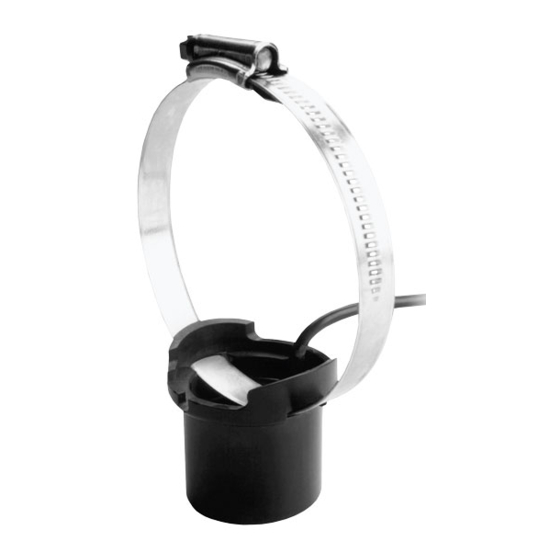
Table of Contents
Advertisement
Quick Links
OWNER'S GUIDE & INSTALLATION INSTRUCTIONS
In-Hull & Trolling Motor
Models: P50, P72, P76, P78, P83
CHIRP Model: P155M
Follow the precautions below for optimal
product performance and to reduce the risk of
property damage, personal injury, and/or death.
WARNING: Always wear safety glasses, a dust mask,
and ear protection when installing.
CAUTION: Chose the transducer designed for your
boat's deadrise angle. Never use adhesive to fill gaps
between the transducer and the hull since this will
greatly reduce the transducer's performance.
CAUTION: Fiberglass Hull—The hull must be SOLID
fiberglass under the transducer. The transducer will
not transmit through coring material such as foam or
balsa wood.
CAUTION: CHIRP transducer—Do not install in the
engine compartment or other hot place. The
transducer may fail if it overheats.
CAUTION: Never pull, carry, or hold the transducer by
the cable. This may sever internal connections.
CAUTION: Do not use adhesive to fill gaps between
the transducer and the hull since this will greatly
reduce the transducer's performance.
CAUTION: Never use solvents. Cleaner, fuel, sealant,
paint, and other products may contain solvents that can
damage plastic parts, especially the transducer's face.
IMPORTANT: Please read the instructions completely
before proceeding with the installation. These
instructions supersede any other instructions in your
instrument manual if they differ.
• For fiberglass hulls only
• Recommended for high-speed boats
• P50, P72, P76, P83, and P155M accommodate a deadrise angle
of 10
or less
• P78 accommodates a deadrise angle of 10
Puck Transducer
– 22
Record the information found on the cable tag for future reference.
Part No._________________Date___________Frequency________kHz
P72
P50, P76, P83, P155M
In-Hull Mount
Tools & Materials
Safety glasses
Dust mask
Ear protection
Duct tape
Pole
Detergent (some installations)
Weak solvent (such as alcohol)
Disk sander (some installations)
Thin sealable plastic bags (some installations)
Cable ties
Water-based lubricant (such as K-Y
Adhesive (see "Selecting the Adhesive" below)
Paper cup (some installations)
Stirrer (some installations)
Sand (some installations)
Grommet(s) (some installations)
Installation In A Cored Fiberglass Hull (see page 4):
Electric drill
Hole saw
Miniature disk sander (such as Dremel® rotary sander)
Repair epoxy (such as Pettit Flexpoxy 7076)
Selecting the Adhesive
CAUTION: Do not use:
• "5 minute" epoxies because they are too brittle.
• RTV (silicone) adhesives because they absorb most of the
sound energy.
A hard adhesive transmit sound best. However, winter
temperature extremes and flexing on trailer rollers can cause it to
de-laminate. Soft adhesives absorb too much sound, so they will
greatly reduce performance. To compromise, use a viscous slow-
cure epoxy or a fairly rigid one-part adhesive sealant.
• Fiberglass hull—Use the 2-part epoxy adhesive supplied.
NOTE: In cold climates, a one-part polyurethane adhesive,
such as Boat-Life's Life Seal
P78
jelly) (some installations)
®
78mm or 3"
®
, may be best.
Advertisement
Table of Contents

Summary of Contents for Airmar P72
- Page 1 Soft adhesives absorb too much sound, so they will • P50, P72, P76, P83, and P155M accommodate a deadrise angle greatly reduce performance. To compromise, use a viscous slow-...
- Page 2 Use one of the test methods below. Figure 1. Selecting the mounting location Copyright © 2005 Airmar Technology Corp. A.For a location near the stern and a minimal deadrise angle— Clean away any build-up of grease and/or dirt with detergent or Mounting Location alcohol.
- Page 3 If the cable must be cut and 1. Using a 78mm or 3" hole saw, cut through the inner skin and the spliced, use Airmar’s splash-proof Junction Box No. 33-035 and core at the selected location (see Figure 7). The core material follow the instructions supplied.
- Page 4 (Europe, Middle East, Africa) Fax: +33.(0)2.23.52.06.49 Figure 8. Location and installation email: sales@airmar-emea.com Copyright © 1998 Airmar Technology Corp. 35 Meadowbrook Drive, Milford, New Hampshire 03055-4613, USA • www.airmar.com Copyright © 2004 - 2016 Airmar Technology Corp. All rights reserved.
















Need help?
Do you have a question about the P72 and is the answer not in the manual?
Questions and answers